Economics Assignment Report: Australia's Economic Analysis
VerifiedAdded on 2021/06/17
|18
|4016
|22
Report
AI Summary
This economics assignment report provides a comprehensive analysis of the Australian economy over the past five years. It delves into key macroeconomic indicators such as GDP, exploring its growth trends and fluctuations, and the factors influencing them. The report also examines inflation rates, unemployment figures, and consumption expenditure patterns, offering insights into the economic well-being of the Australian population. Furthermore, it investigates the growth of trade and the performance of various industries, particularly the service sector, providing a holistic overview of the country's economic landscape. The analysis includes graphical representations of data, such as GDP and inflation rates, to visually demonstrate the trends and patterns discussed. The report also touches upon the policy structure and its influence on the economic dynamics, offering a comprehensive understanding of the Australian economy's performance and stability.
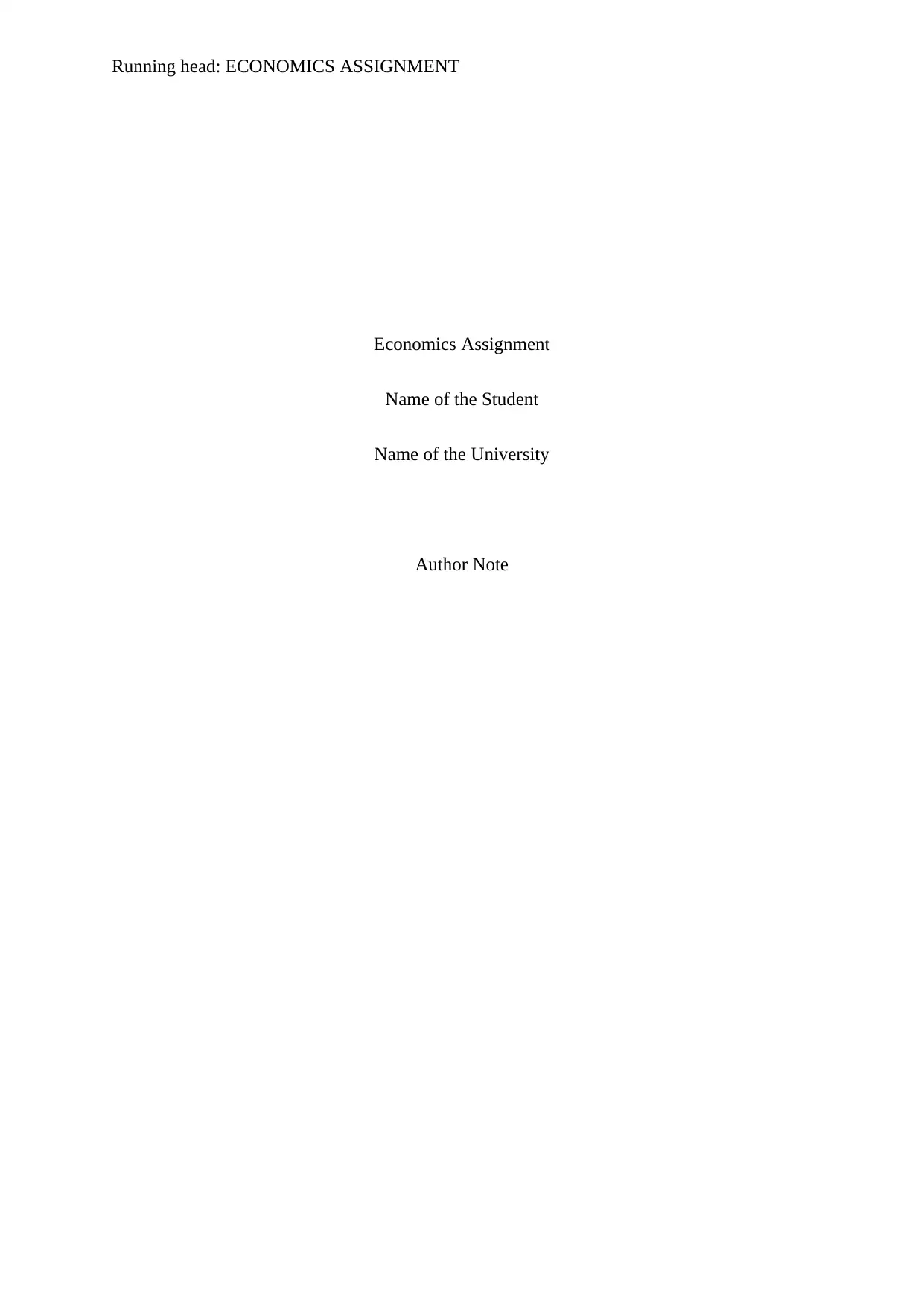
Running head: ECONOMICS ASSIGNMENT
Economics Assignment
Name of the Student
Name of the University
Author Note
Economics Assignment
Name of the Student
Name of the University
Author Note
Paraphrase This Document
Need a fresh take? Get an instant paraphrase of this document with our AI Paraphraser
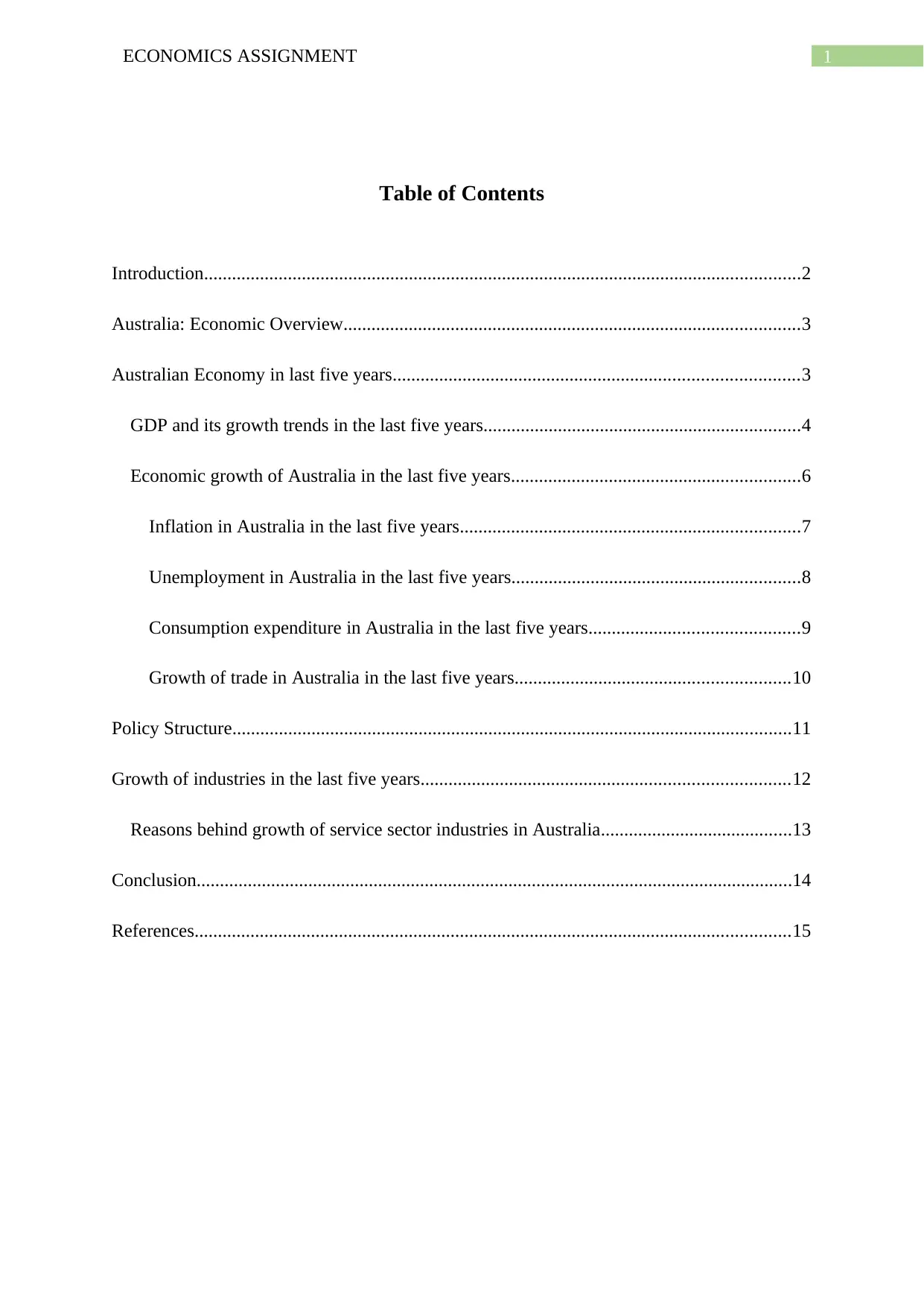
1ECONOMICS ASSIGNMENT
Table of Contents
Introduction................................................................................................................................2
Australia: Economic Overview..................................................................................................3
Australian Economy in last five years.......................................................................................3
GDP and its growth trends in the last five years....................................................................4
Economic growth of Australia in the last five years..............................................................6
Inflation in Australia in the last five years.........................................................................7
Unemployment in Australia in the last five years..............................................................8
Consumption expenditure in Australia in the last five years.............................................9
Growth of trade in Australia in the last five years...........................................................10
Policy Structure........................................................................................................................11
Growth of industries in the last five years...............................................................................12
Reasons behind growth of service sector industries in Australia.........................................13
Conclusion................................................................................................................................14
References................................................................................................................................15
Table of Contents
Introduction................................................................................................................................2
Australia: Economic Overview..................................................................................................3
Australian Economy in last five years.......................................................................................3
GDP and its growth trends in the last five years....................................................................4
Economic growth of Australia in the last five years..............................................................6
Inflation in Australia in the last five years.........................................................................7
Unemployment in Australia in the last five years..............................................................8
Consumption expenditure in Australia in the last five years.............................................9
Growth of trade in Australia in the last five years...........................................................10
Policy Structure........................................................................................................................11
Growth of industries in the last five years...............................................................................12
Reasons behind growth of service sector industries in Australia.........................................13
Conclusion................................................................................................................................14
References................................................................................................................................15
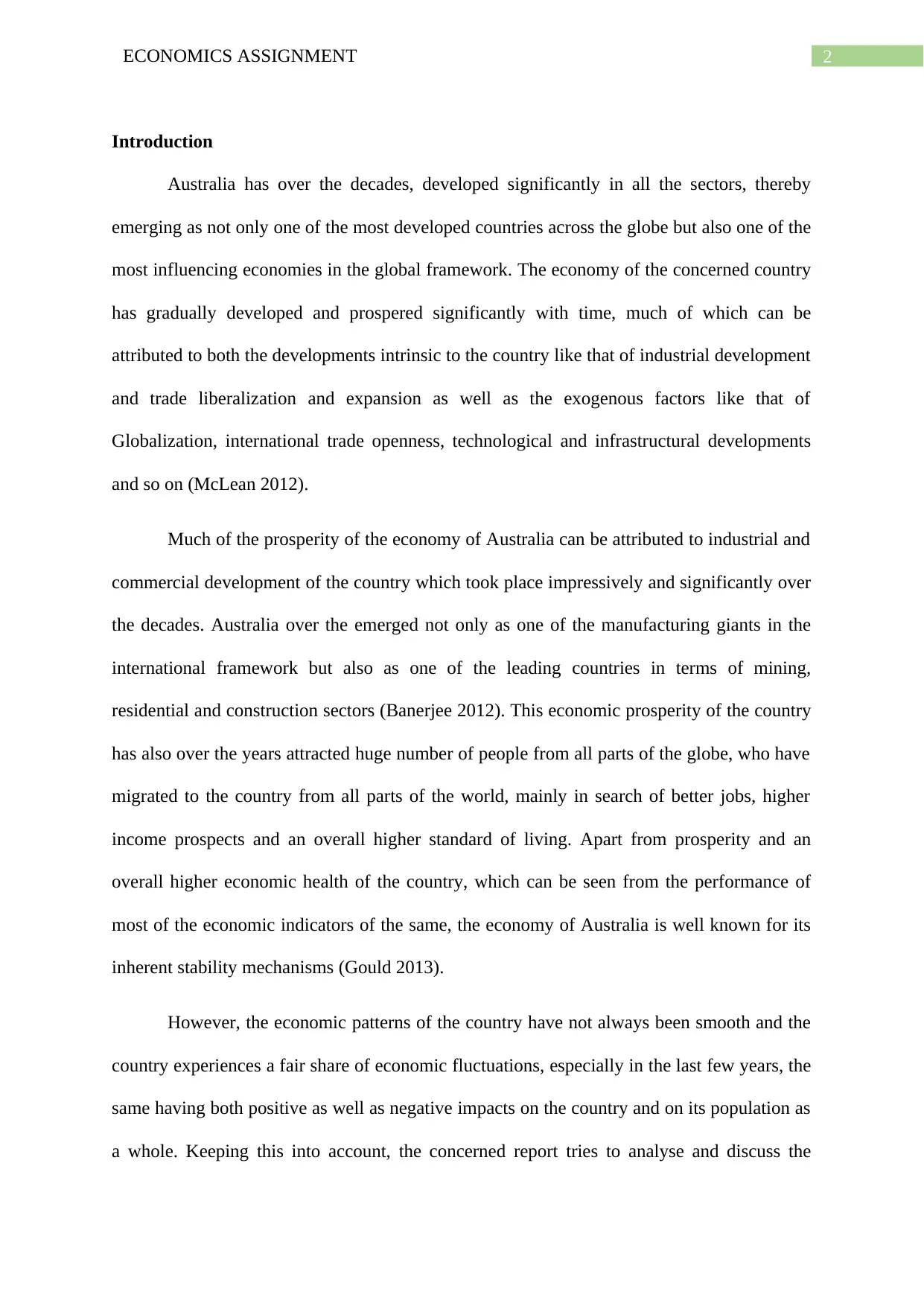
2ECONOMICS ASSIGNMENT
Introduction
Australia has over the decades, developed significantly in all the sectors, thereby
emerging as not only one of the most developed countries across the globe but also one of the
most influencing economies in the global framework. The economy of the concerned country
has gradually developed and prospered significantly with time, much of which can be
attributed to both the developments intrinsic to the country like that of industrial development
and trade liberalization and expansion as well as the exogenous factors like that of
Globalization, international trade openness, technological and infrastructural developments
and so on (McLean 2012).
Much of the prosperity of the economy of Australia can be attributed to industrial and
commercial development of the country which took place impressively and significantly over
the decades. Australia over the emerged not only as one of the manufacturing giants in the
international framework but also as one of the leading countries in terms of mining,
residential and construction sectors (Banerjee 2012). This economic prosperity of the country
has also over the years attracted huge number of people from all parts of the globe, who have
migrated to the country from all parts of the world, mainly in search of better jobs, higher
income prospects and an overall higher standard of living. Apart from prosperity and an
overall higher economic health of the country, which can be seen from the performance of
most of the economic indicators of the same, the economy of Australia is well known for its
inherent stability mechanisms (Gould 2013).
However, the economic patterns of the country have not always been smooth and the
country experiences a fair share of economic fluctuations, especially in the last few years, the
same having both positive as well as negative impacts on the country and on its population as
a whole. Keeping this into account, the concerned report tries to analyse and discuss the
Introduction
Australia has over the decades, developed significantly in all the sectors, thereby
emerging as not only one of the most developed countries across the globe but also one of the
most influencing economies in the global framework. The economy of the concerned country
has gradually developed and prospered significantly with time, much of which can be
attributed to both the developments intrinsic to the country like that of industrial development
and trade liberalization and expansion as well as the exogenous factors like that of
Globalization, international trade openness, technological and infrastructural developments
and so on (McLean 2012).
Much of the prosperity of the economy of Australia can be attributed to industrial and
commercial development of the country which took place impressively and significantly over
the decades. Australia over the emerged not only as one of the manufacturing giants in the
international framework but also as one of the leading countries in terms of mining,
residential and construction sectors (Banerjee 2012). This economic prosperity of the country
has also over the years attracted huge number of people from all parts of the globe, who have
migrated to the country from all parts of the world, mainly in search of better jobs, higher
income prospects and an overall higher standard of living. Apart from prosperity and an
overall higher economic health of the country, which can be seen from the performance of
most of the economic indicators of the same, the economy of Australia is well known for its
inherent stability mechanisms (Gould 2013).
However, the economic patterns of the country have not always been smooth and the
country experiences a fair share of economic fluctuations, especially in the last few years, the
same having both positive as well as negative impacts on the country and on its population as
a whole. Keeping this into account, the concerned report tries to analyse and discuss the
⊘ This is a preview!⊘
Do you want full access?
Subscribe today to unlock all pages.

Trusted by 1+ million students worldwide
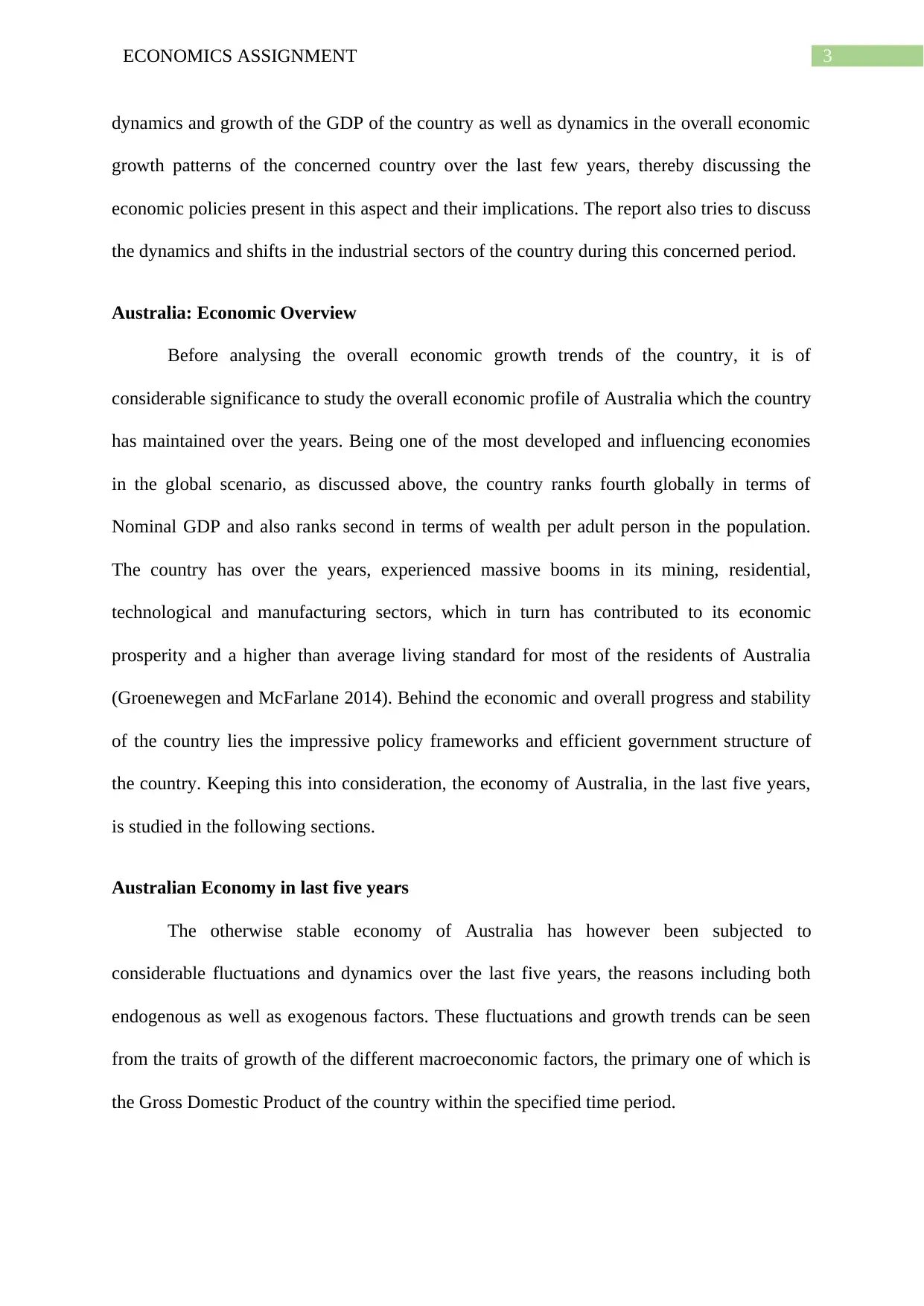
3ECONOMICS ASSIGNMENT
dynamics and growth of the GDP of the country as well as dynamics in the overall economic
growth patterns of the concerned country over the last few years, thereby discussing the
economic policies present in this aspect and their implications. The report also tries to discuss
the dynamics and shifts in the industrial sectors of the country during this concerned period.
Australia: Economic Overview
Before analysing the overall economic growth trends of the country, it is of
considerable significance to study the overall economic profile of Australia which the country
has maintained over the years. Being one of the most developed and influencing economies
in the global scenario, as discussed above, the country ranks fourth globally in terms of
Nominal GDP and also ranks second in terms of wealth per adult person in the population.
The country has over the years, experienced massive booms in its mining, residential,
technological and manufacturing sectors, which in turn has contributed to its economic
prosperity and a higher than average living standard for most of the residents of Australia
(Groenewegen and McFarlane 2014). Behind the economic and overall progress and stability
of the country lies the impressive policy frameworks and efficient government structure of
the country. Keeping this into consideration, the economy of Australia, in the last five years,
is studied in the following sections.
Australian Economy in last five years
The otherwise stable economy of Australia has however been subjected to
considerable fluctuations and dynamics over the last five years, the reasons including both
endogenous as well as exogenous factors. These fluctuations and growth trends can be seen
from the traits of growth of the different macroeconomic factors, the primary one of which is
the Gross Domestic Product of the country within the specified time period.
dynamics and growth of the GDP of the country as well as dynamics in the overall economic
growth patterns of the concerned country over the last few years, thereby discussing the
economic policies present in this aspect and their implications. The report also tries to discuss
the dynamics and shifts in the industrial sectors of the country during this concerned period.
Australia: Economic Overview
Before analysing the overall economic growth trends of the country, it is of
considerable significance to study the overall economic profile of Australia which the country
has maintained over the years. Being one of the most developed and influencing economies
in the global scenario, as discussed above, the country ranks fourth globally in terms of
Nominal GDP and also ranks second in terms of wealth per adult person in the population.
The country has over the years, experienced massive booms in its mining, residential,
technological and manufacturing sectors, which in turn has contributed to its economic
prosperity and a higher than average living standard for most of the residents of Australia
(Groenewegen and McFarlane 2014). Behind the economic and overall progress and stability
of the country lies the impressive policy frameworks and efficient government structure of
the country. Keeping this into consideration, the economy of Australia, in the last five years,
is studied in the following sections.
Australian Economy in last five years
The otherwise stable economy of Australia has however been subjected to
considerable fluctuations and dynamics over the last five years, the reasons including both
endogenous as well as exogenous factors. These fluctuations and growth trends can be seen
from the traits of growth of the different macroeconomic factors, the primary one of which is
the Gross Domestic Product of the country within the specified time period.
Paraphrase This Document
Need a fresh take? Get an instant paraphrase of this document with our AI Paraphraser
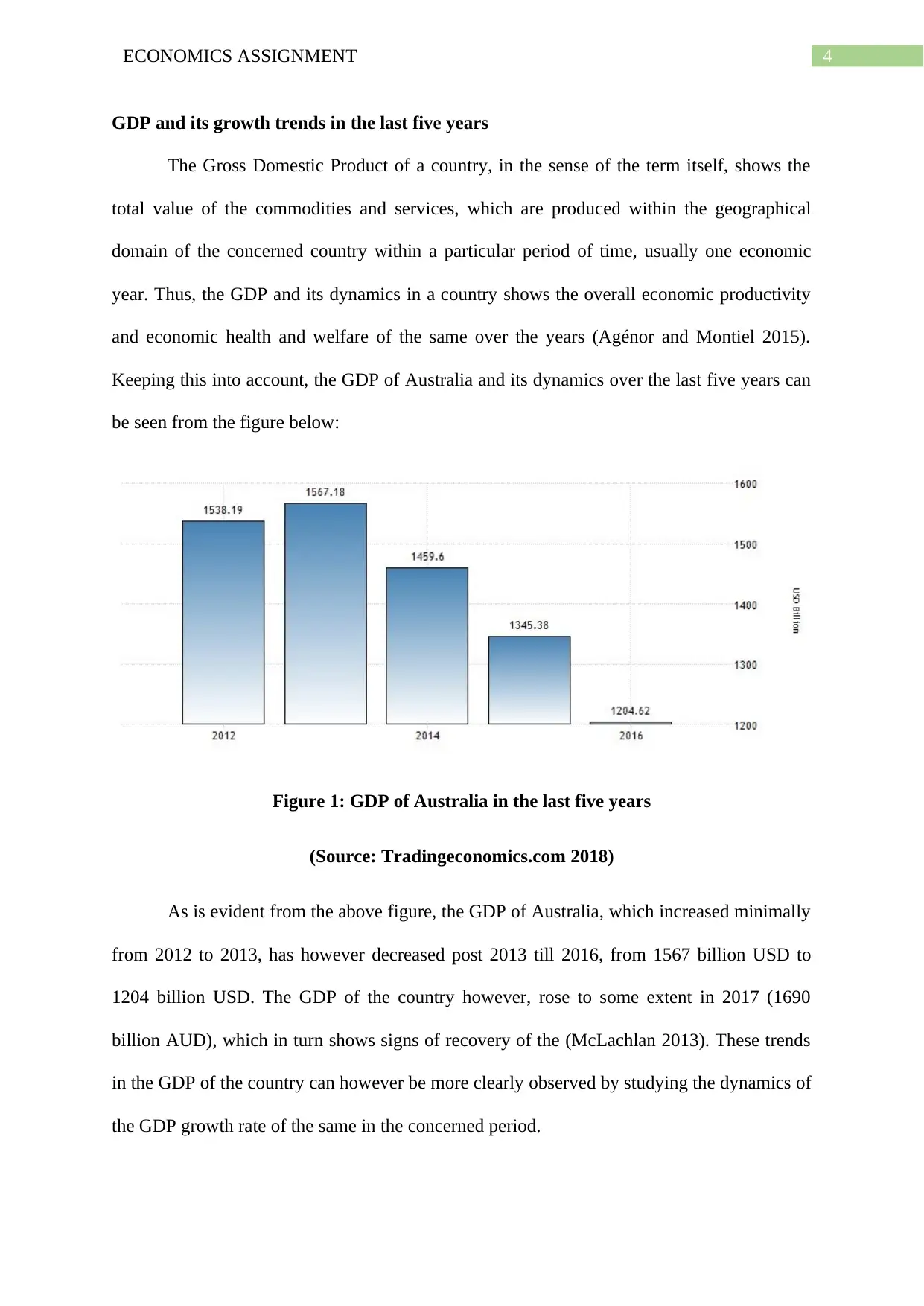
4ECONOMICS ASSIGNMENT
GDP and its growth trends in the last five years
The Gross Domestic Product of a country, in the sense of the term itself, shows the
total value of the commodities and services, which are produced within the geographical
domain of the concerned country within a particular period of time, usually one economic
year. Thus, the GDP and its dynamics in a country shows the overall economic productivity
and economic health and welfare of the same over the years (Agénor and Montiel 2015).
Keeping this into account, the GDP of Australia and its dynamics over the last five years can
be seen from the figure below:
Figure 1: GDP of Australia in the last five years
(Source: Tradingeconomics.com 2018)
As is evident from the above figure, the GDP of Australia, which increased minimally
from 2012 to 2013, has however decreased post 2013 till 2016, from 1567 billion USD to
1204 billion USD. The GDP of the country however, rose to some extent in 2017 (1690
billion AUD), which in turn shows signs of recovery of the (McLachlan 2013). These trends
in the GDP of the country can however be more clearly observed by studying the dynamics of
the GDP growth rate of the same in the concerned period.
GDP and its growth trends in the last five years
The Gross Domestic Product of a country, in the sense of the term itself, shows the
total value of the commodities and services, which are produced within the geographical
domain of the concerned country within a particular period of time, usually one economic
year. Thus, the GDP and its dynamics in a country shows the overall economic productivity
and economic health and welfare of the same over the years (Agénor and Montiel 2015).
Keeping this into account, the GDP of Australia and its dynamics over the last five years can
be seen from the figure below:
Figure 1: GDP of Australia in the last five years
(Source: Tradingeconomics.com 2018)
As is evident from the above figure, the GDP of Australia, which increased minimally
from 2012 to 2013, has however decreased post 2013 till 2016, from 1567 billion USD to
1204 billion USD. The GDP of the country however, rose to some extent in 2017 (1690
billion AUD), which in turn shows signs of recovery of the (McLachlan 2013). These trends
in the GDP of the country can however be more clearly observed by studying the dynamics of
the GDP growth rate of the same in the concerned period.
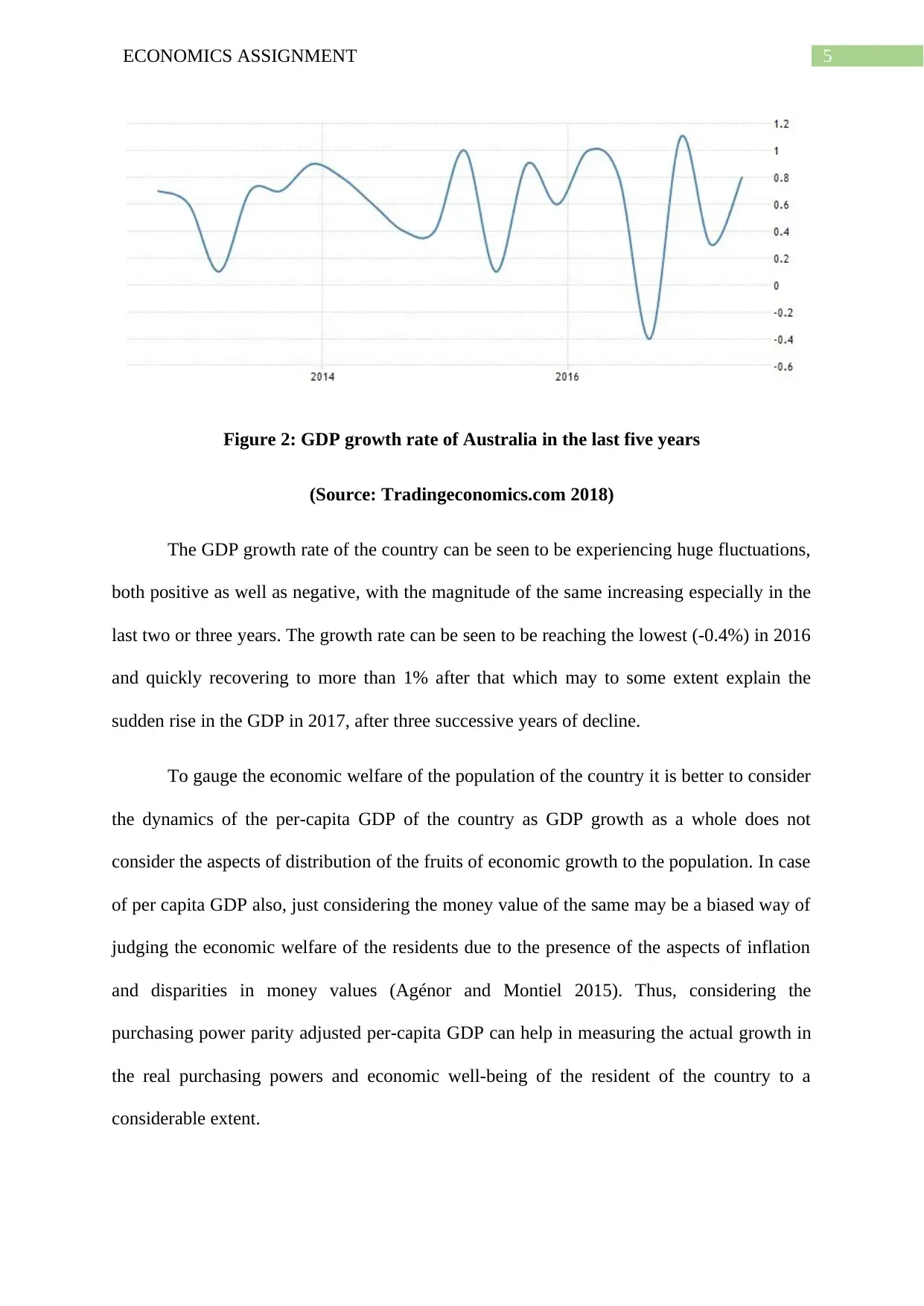
5ECONOMICS ASSIGNMENT
Figure 2: GDP growth rate of Australia in the last five years
(Source: Tradingeconomics.com 2018)
The GDP growth rate of the country can be seen to be experiencing huge fluctuations,
both positive as well as negative, with the magnitude of the same increasing especially in the
last two or three years. The growth rate can be seen to be reaching the lowest (-0.4%) in 2016
and quickly recovering to more than 1% after that which may to some extent explain the
sudden rise in the GDP in 2017, after three successive years of decline.
To gauge the economic welfare of the population of the country it is better to consider
the dynamics of the per-capita GDP of the country as GDP growth as a whole does not
consider the aspects of distribution of the fruits of economic growth to the population. In case
of per capita GDP also, just considering the money value of the same may be a biased way of
judging the economic welfare of the residents due to the presence of the aspects of inflation
and disparities in money values (Agénor and Montiel 2015). Thus, considering the
purchasing power parity adjusted per-capita GDP can help in measuring the actual growth in
the real purchasing powers and economic well-being of the resident of the country to a
considerable extent.
Figure 2: GDP growth rate of Australia in the last five years
(Source: Tradingeconomics.com 2018)
The GDP growth rate of the country can be seen to be experiencing huge fluctuations,
both positive as well as negative, with the magnitude of the same increasing especially in the
last two or three years. The growth rate can be seen to be reaching the lowest (-0.4%) in 2016
and quickly recovering to more than 1% after that which may to some extent explain the
sudden rise in the GDP in 2017, after three successive years of decline.
To gauge the economic welfare of the population of the country it is better to consider
the dynamics of the per-capita GDP of the country as GDP growth as a whole does not
consider the aspects of distribution of the fruits of economic growth to the population. In case
of per capita GDP also, just considering the money value of the same may be a biased way of
judging the economic welfare of the residents due to the presence of the aspects of inflation
and disparities in money values (Agénor and Montiel 2015). Thus, considering the
purchasing power parity adjusted per-capita GDP can help in measuring the actual growth in
the real purchasing powers and economic well-being of the resident of the country to a
considerable extent.
⊘ This is a preview!⊘
Do you want full access?
Subscribe today to unlock all pages.

Trusted by 1+ million students worldwide
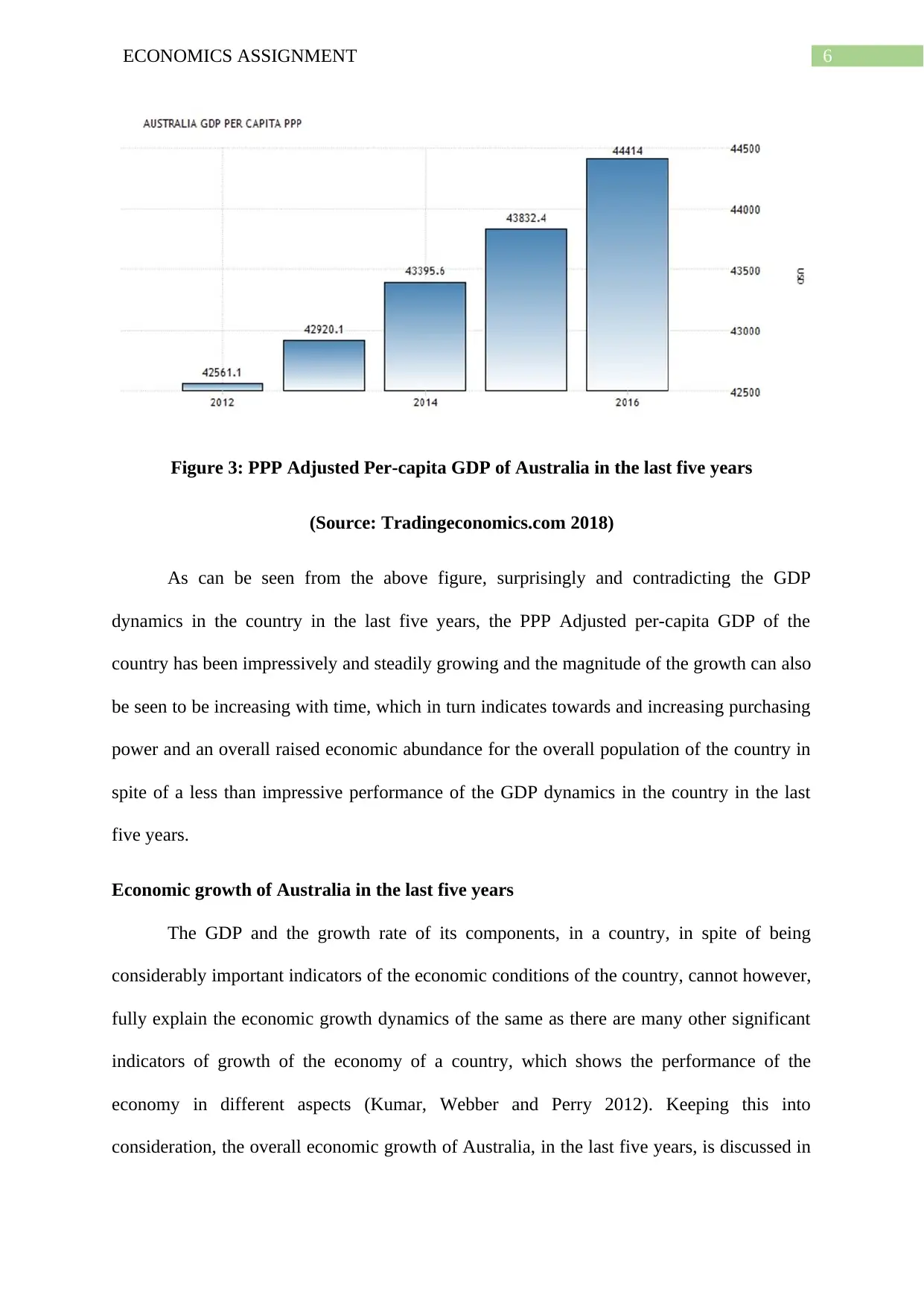
6ECONOMICS ASSIGNMENT
Figure 3: PPP Adjusted Per-capita GDP of Australia in the last five years
(Source: Tradingeconomics.com 2018)
As can be seen from the above figure, surprisingly and contradicting the GDP
dynamics in the country in the last five years, the PPP Adjusted per-capita GDP of the
country has been impressively and steadily growing and the magnitude of the growth can also
be seen to be increasing with time, which in turn indicates towards and increasing purchasing
power and an overall raised economic abundance for the overall population of the country in
spite of a less than impressive performance of the GDP dynamics in the country in the last
five years.
Economic growth of Australia in the last five years
The GDP and the growth rate of its components, in a country, in spite of being
considerably important indicators of the economic conditions of the country, cannot however,
fully explain the economic growth dynamics of the same as there are many other significant
indicators of growth of the economy of a country, which shows the performance of the
economy in different aspects (Kumar, Webber and Perry 2012). Keeping this into
consideration, the overall economic growth of Australia, in the last five years, is discussed in
Figure 3: PPP Adjusted Per-capita GDP of Australia in the last five years
(Source: Tradingeconomics.com 2018)
As can be seen from the above figure, surprisingly and contradicting the GDP
dynamics in the country in the last five years, the PPP Adjusted per-capita GDP of the
country has been impressively and steadily growing and the magnitude of the growth can also
be seen to be increasing with time, which in turn indicates towards and increasing purchasing
power and an overall raised economic abundance for the overall population of the country in
spite of a less than impressive performance of the GDP dynamics in the country in the last
five years.
Economic growth of Australia in the last five years
The GDP and the growth rate of its components, in a country, in spite of being
considerably important indicators of the economic conditions of the country, cannot however,
fully explain the economic growth dynamics of the same as there are many other significant
indicators of growth of the economy of a country, which shows the performance of the
economy in different aspects (Kumar, Webber and Perry 2012). Keeping this into
consideration, the overall economic growth of Australia, in the last five years, is discussed in
Paraphrase This Document
Need a fresh take? Get an instant paraphrase of this document with our AI Paraphraser
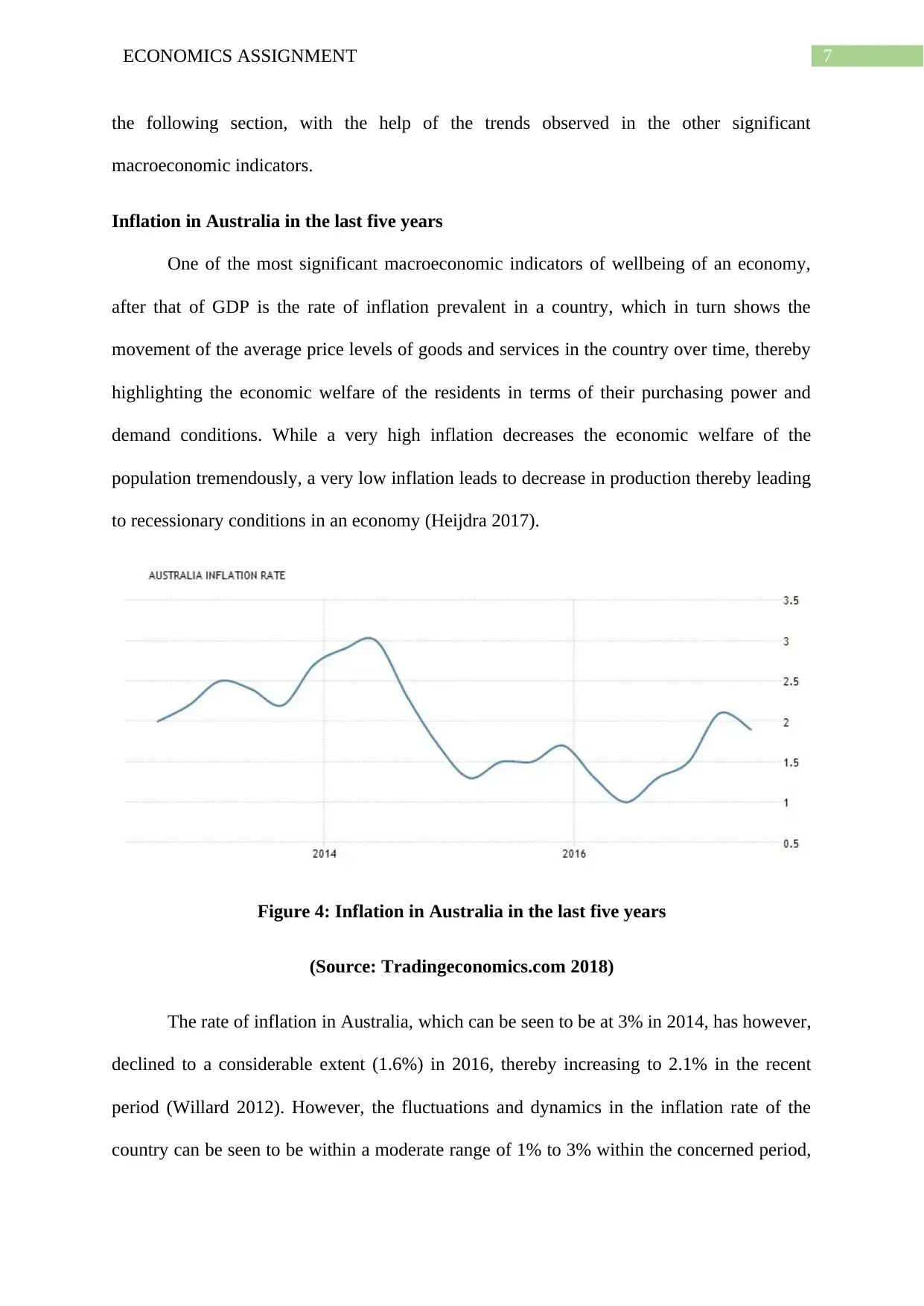
7ECONOMICS ASSIGNMENT
the following section, with the help of the trends observed in the other significant
macroeconomic indicators.
Inflation in Australia in the last five years
One of the most significant macroeconomic indicators of wellbeing of an economy,
after that of GDP is the rate of inflation prevalent in a country, which in turn shows the
movement of the average price levels of goods and services in the country over time, thereby
highlighting the economic welfare of the residents in terms of their purchasing power and
demand conditions. While a very high inflation decreases the economic welfare of the
population tremendously, a very low inflation leads to decrease in production thereby leading
to recessionary conditions in an economy (Heijdra 2017).
Figure 4: Inflation in Australia in the last five years
(Source: Tradingeconomics.com 2018)
The rate of inflation in Australia, which can be seen to be at 3% in 2014, has however,
declined to a considerable extent (1.6%) in 2016, thereby increasing to 2.1% in the recent
period (Willard 2012). However, the fluctuations and dynamics in the inflation rate of the
country can be seen to be within a moderate range of 1% to 3% within the concerned period,
the following section, with the help of the trends observed in the other significant
macroeconomic indicators.
Inflation in Australia in the last five years
One of the most significant macroeconomic indicators of wellbeing of an economy,
after that of GDP is the rate of inflation prevalent in a country, which in turn shows the
movement of the average price levels of goods and services in the country over time, thereby
highlighting the economic welfare of the residents in terms of their purchasing power and
demand conditions. While a very high inflation decreases the economic welfare of the
population tremendously, a very low inflation leads to decrease in production thereby leading
to recessionary conditions in an economy (Heijdra 2017).
Figure 4: Inflation in Australia in the last five years
(Source: Tradingeconomics.com 2018)
The rate of inflation in Australia, which can be seen to be at 3% in 2014, has however,
declined to a considerable extent (1.6%) in 2016, thereby increasing to 2.1% in the recent
period (Willard 2012). However, the fluctuations and dynamics in the inflation rate of the
country can be seen to be within a moderate range of 1% to 3% within the concerned period,
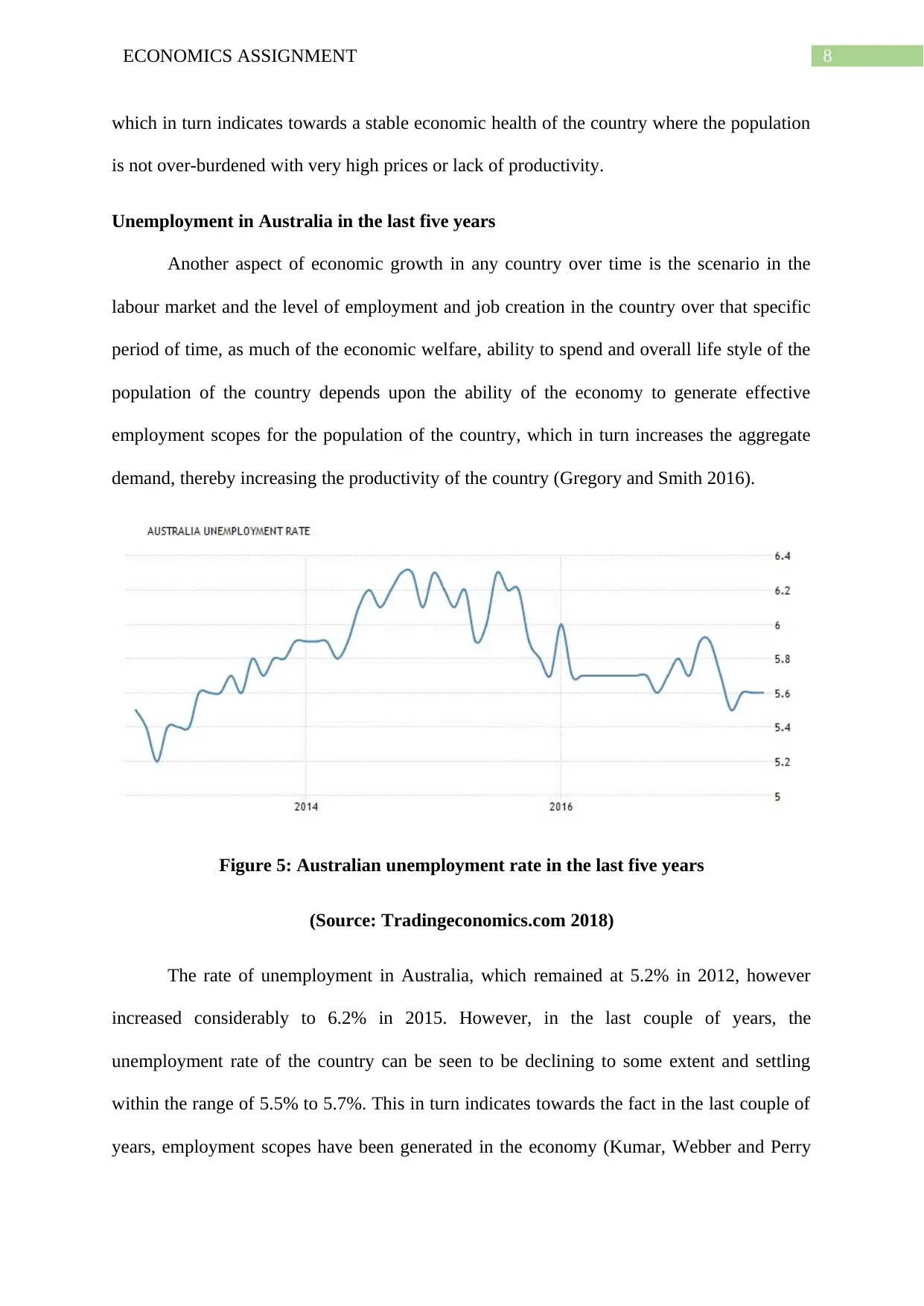
8ECONOMICS ASSIGNMENT
which in turn indicates towards a stable economic health of the country where the population
is not over-burdened with very high prices or lack of productivity.
Unemployment in Australia in the last five years
Another aspect of economic growth in any country over time is the scenario in the
labour market and the level of employment and job creation in the country over that specific
period of time, as much of the economic welfare, ability to spend and overall life style of the
population of the country depends upon the ability of the economy to generate effective
employment scopes for the population of the country, which in turn increases the aggregate
demand, thereby increasing the productivity of the country (Gregory and Smith 2016).
Figure 5: Australian unemployment rate in the last five years
(Source: Tradingeconomics.com 2018)
The rate of unemployment in Australia, which remained at 5.2% in 2012, however
increased considerably to 6.2% in 2015. However, in the last couple of years, the
unemployment rate of the country can be seen to be declining to some extent and settling
within the range of 5.5% to 5.7%. This in turn indicates towards the fact in the last couple of
years, employment scopes have been generated in the economy (Kumar, Webber and Perry
which in turn indicates towards a stable economic health of the country where the population
is not over-burdened with very high prices or lack of productivity.
Unemployment in Australia in the last five years
Another aspect of economic growth in any country over time is the scenario in the
labour market and the level of employment and job creation in the country over that specific
period of time, as much of the economic welfare, ability to spend and overall life style of the
population of the country depends upon the ability of the economy to generate effective
employment scopes for the population of the country, which in turn increases the aggregate
demand, thereby increasing the productivity of the country (Gregory and Smith 2016).
Figure 5: Australian unemployment rate in the last five years
(Source: Tradingeconomics.com 2018)
The rate of unemployment in Australia, which remained at 5.2% in 2012, however
increased considerably to 6.2% in 2015. However, in the last couple of years, the
unemployment rate of the country can be seen to be declining to some extent and settling
within the range of 5.5% to 5.7%. This in turn indicates towards the fact in the last couple of
years, employment scopes have been generated in the economy (Kumar, Webber and Perry
⊘ This is a preview!⊘
Do you want full access?
Subscribe today to unlock all pages.

Trusted by 1+ million students worldwide
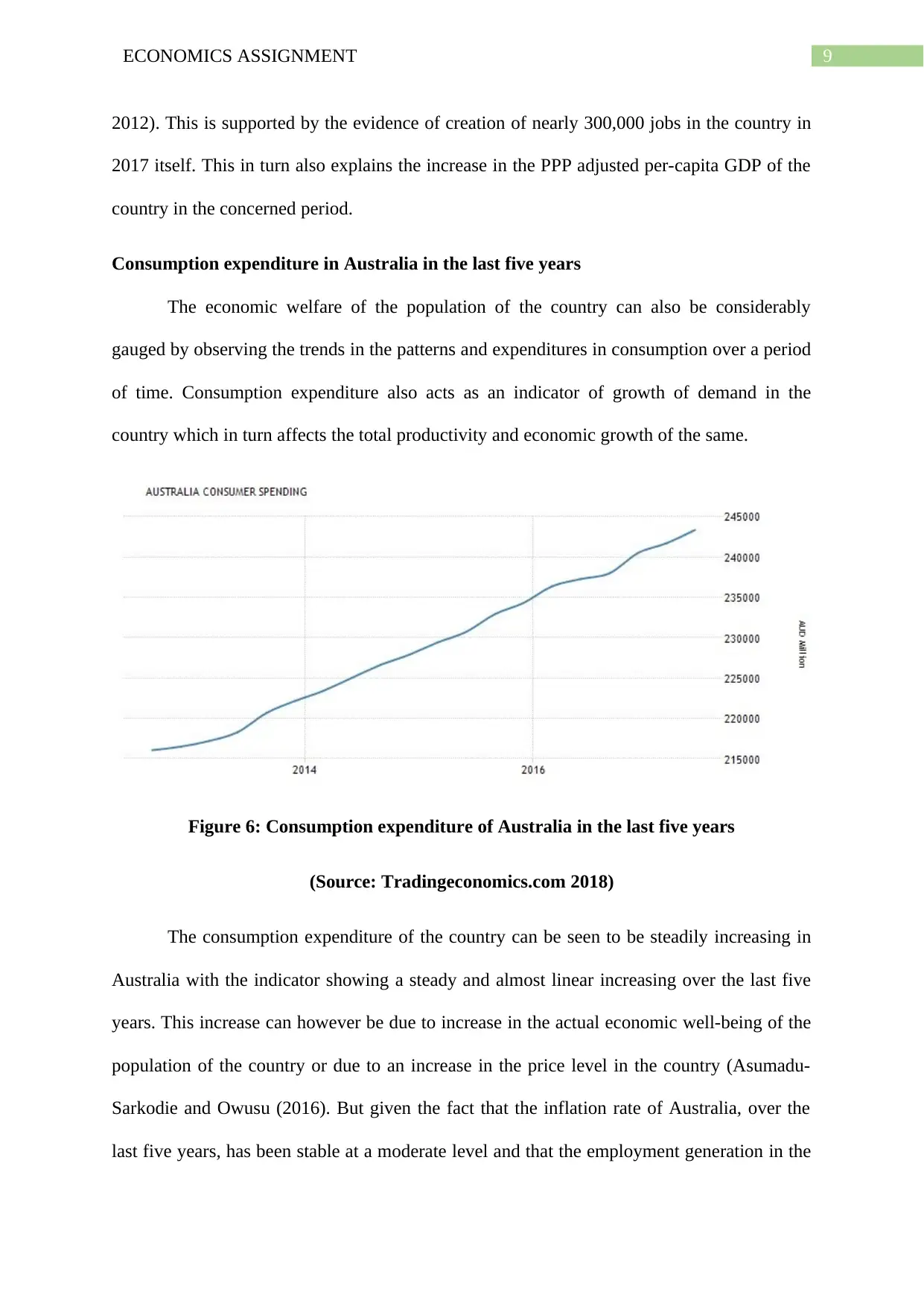
9ECONOMICS ASSIGNMENT
2012). This is supported by the evidence of creation of nearly 300,000 jobs in the country in
2017 itself. This in turn also explains the increase in the PPP adjusted per-capita GDP of the
country in the concerned period.
Consumption expenditure in Australia in the last five years
The economic welfare of the population of the country can also be considerably
gauged by observing the trends in the patterns and expenditures in consumption over a period
of time. Consumption expenditure also acts as an indicator of growth of demand in the
country which in turn affects the total productivity and economic growth of the same.
Figure 6: Consumption expenditure of Australia in the last five years
(Source: Tradingeconomics.com 2018)
The consumption expenditure of the country can be seen to be steadily increasing in
Australia with the indicator showing a steady and almost linear increasing over the last five
years. This increase can however be due to increase in the actual economic well-being of the
population of the country or due to an increase in the price level in the country (Asumadu-
Sarkodie and Owusu (2016). But given the fact that the inflation rate of Australia, over the
last five years, has been stable at a moderate level and that the employment generation in the
2012). This is supported by the evidence of creation of nearly 300,000 jobs in the country in
2017 itself. This in turn also explains the increase in the PPP adjusted per-capita GDP of the
country in the concerned period.
Consumption expenditure in Australia in the last five years
The economic welfare of the population of the country can also be considerably
gauged by observing the trends in the patterns and expenditures in consumption over a period
of time. Consumption expenditure also acts as an indicator of growth of demand in the
country which in turn affects the total productivity and economic growth of the same.
Figure 6: Consumption expenditure of Australia in the last five years
(Source: Tradingeconomics.com 2018)
The consumption expenditure of the country can be seen to be steadily increasing in
Australia with the indicator showing a steady and almost linear increasing over the last five
years. This increase can however be due to increase in the actual economic well-being of the
population of the country or due to an increase in the price level in the country (Asumadu-
Sarkodie and Owusu (2016). But given the fact that the inflation rate of Australia, over the
last five years, has been stable at a moderate level and that the employment generation in the
Paraphrase This Document
Need a fresh take? Get an instant paraphrase of this document with our AI Paraphraser
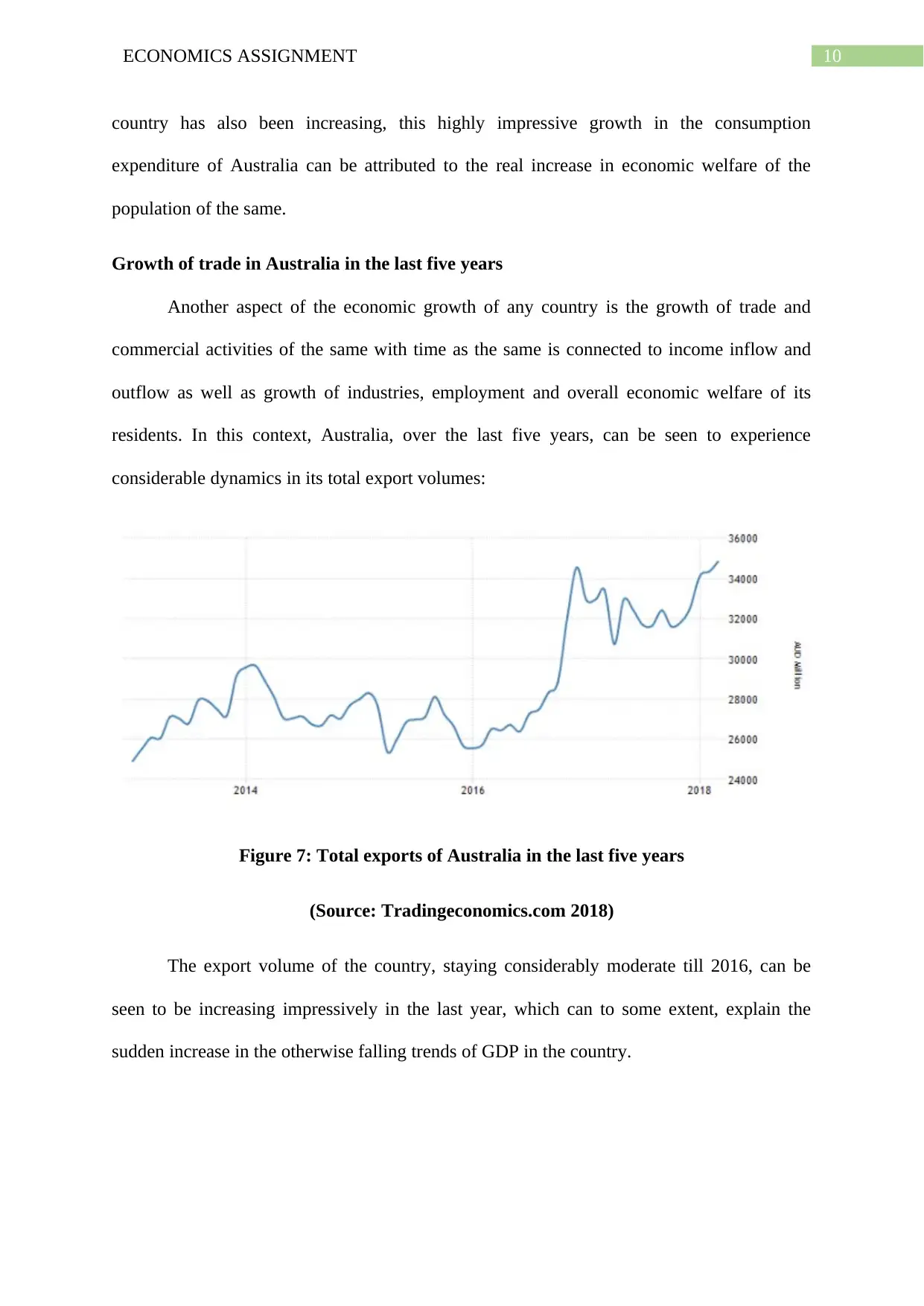
10ECONOMICS ASSIGNMENT
country has also been increasing, this highly impressive growth in the consumption
expenditure of Australia can be attributed to the real increase in economic welfare of the
population of the same.
Growth of trade in Australia in the last five years
Another aspect of the economic growth of any country is the growth of trade and
commercial activities of the same with time as the same is connected to income inflow and
outflow as well as growth of industries, employment and overall economic welfare of its
residents. In this context, Australia, over the last five years, can be seen to experience
considerable dynamics in its total export volumes:
Figure 7: Total exports of Australia in the last five years
(Source: Tradingeconomics.com 2018)
The export volume of the country, staying considerably moderate till 2016, can be
seen to be increasing impressively in the last year, which can to some extent, explain the
sudden increase in the otherwise falling trends of GDP in the country.
country has also been increasing, this highly impressive growth in the consumption
expenditure of Australia can be attributed to the real increase in economic welfare of the
population of the same.
Growth of trade in Australia in the last five years
Another aspect of the economic growth of any country is the growth of trade and
commercial activities of the same with time as the same is connected to income inflow and
outflow as well as growth of industries, employment and overall economic welfare of its
residents. In this context, Australia, over the last five years, can be seen to experience
considerable dynamics in its total export volumes:
Figure 7: Total exports of Australia in the last five years
(Source: Tradingeconomics.com 2018)
The export volume of the country, staying considerably moderate till 2016, can be
seen to be increasing impressively in the last year, which can to some extent, explain the
sudden increase in the otherwise falling trends of GDP in the country.
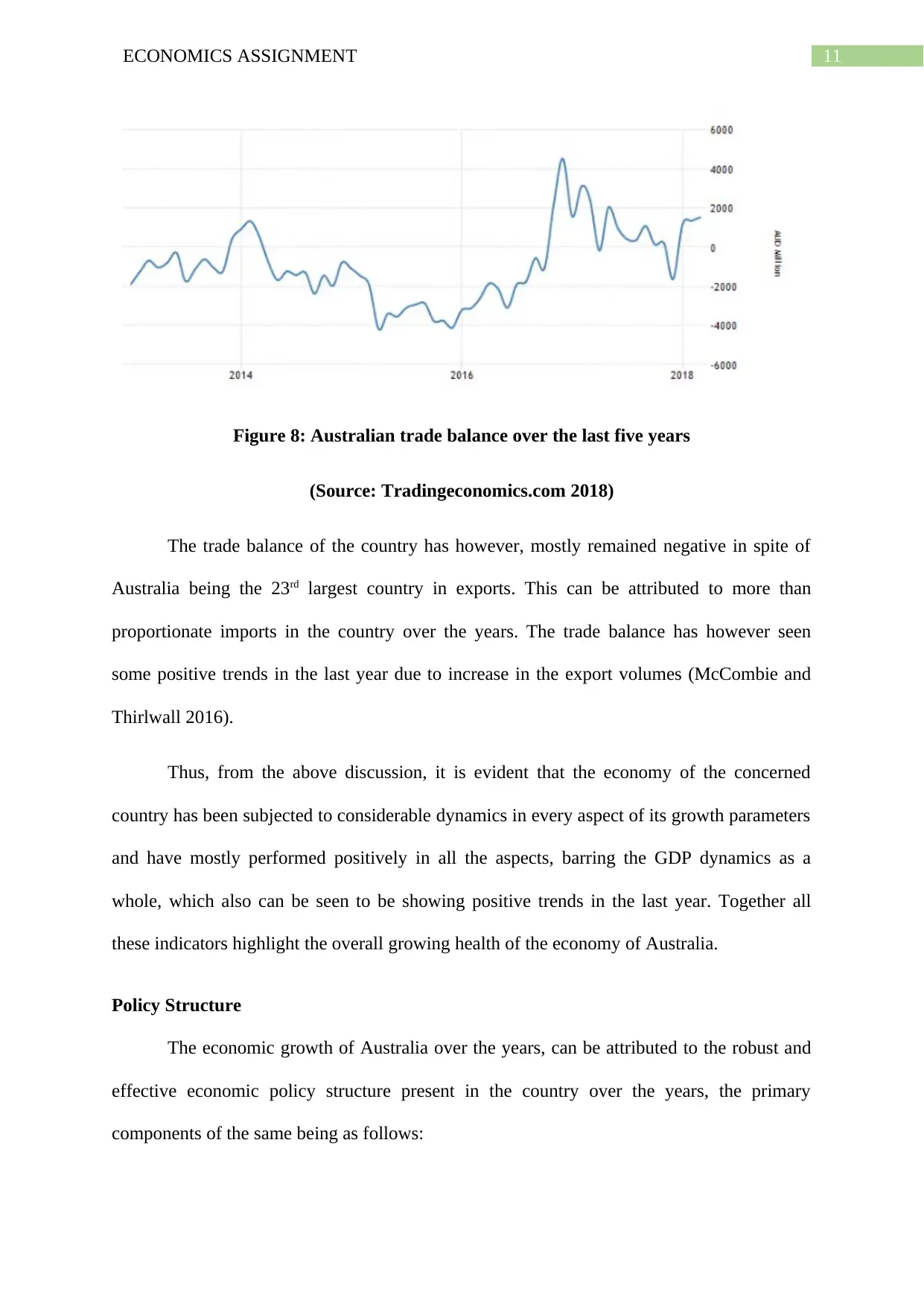
11ECONOMICS ASSIGNMENT
Figure 8: Australian trade balance over the last five years
(Source: Tradingeconomics.com 2018)
The trade balance of the country has however, mostly remained negative in spite of
Australia being the 23rd largest country in exports. This can be attributed to more than
proportionate imports in the country over the years. The trade balance has however seen
some positive trends in the last year due to increase in the export volumes (McCombie and
Thirlwall 2016).
Thus, from the above discussion, it is evident that the economy of the concerned
country has been subjected to considerable dynamics in every aspect of its growth parameters
and have mostly performed positively in all the aspects, barring the GDP dynamics as a
whole, which also can be seen to be showing positive trends in the last year. Together all
these indicators highlight the overall growing health of the economy of Australia.
Policy Structure
The economic growth of Australia over the years, can be attributed to the robust and
effective economic policy structure present in the country over the years, the primary
components of the same being as follows:
Figure 8: Australian trade balance over the last five years
(Source: Tradingeconomics.com 2018)
The trade balance of the country has however, mostly remained negative in spite of
Australia being the 23rd largest country in exports. This can be attributed to more than
proportionate imports in the country over the years. The trade balance has however seen
some positive trends in the last year due to increase in the export volumes (McCombie and
Thirlwall 2016).
Thus, from the above discussion, it is evident that the economy of the concerned
country has been subjected to considerable dynamics in every aspect of its growth parameters
and have mostly performed positively in all the aspects, barring the GDP dynamics as a
whole, which also can be seen to be showing positive trends in the last year. Together all
these indicators highlight the overall growing health of the economy of Australia.
Policy Structure
The economic growth of Australia over the years, can be attributed to the robust and
effective economic policy structure present in the country over the years, the primary
components of the same being as follows:
⊘ This is a preview!⊘
Do you want full access?
Subscribe today to unlock all pages.

Trusted by 1+ million students worldwide
1 out of 18
Related Documents
Your All-in-One AI-Powered Toolkit for Academic Success.
+13062052269
info@desklib.com
Available 24*7 on WhatsApp / Email
![[object Object]](/_next/static/media/star-bottom.7253800d.svg)
Unlock your academic potential
Copyright © 2020–2025 A2Z Services. All Rights Reserved. Developed and managed by ZUCOL.




